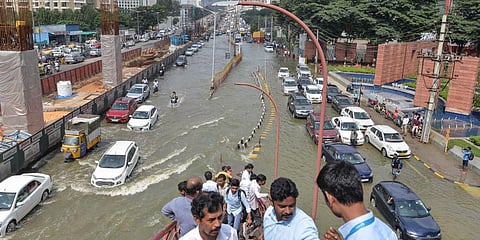

Bengaluru roads that resembled overflowing rivers last week have dried up. The usual chock-a-block traffic is back.
Over the next few weeks, perhaps in days, not many would remember the deluge that looked like a scene straight out of the movie “2012”.
Politicians, in power and opposition, will move on after a few spot visits and the usual blame game.
The miserable situation that plays out year after year exposes the absence of long-term planning and the governance deficit.
A lack of political will to take tough measures, absence of proper coordination among various government agencies, politicians-officials-realtors nexus and corruption resulted in the horrendous situation that the city faces.
Citizens feel betrayed by the system. Infrastructure development has not been able to keep pace with the exponential growth of the city that has emerged as an engine of India’s economic progress.
The Outer Ring Road Companies Association (ORRCA), which represents major IT and banking companies on the Outer Ring Road (ORR) in Bengaluru, estimates that the flooding on August 30 led to a loss of Rs 225 crore as employees were stuck on roads for over five hours.
Though companies claim that they may have to move work outside Bengaluru and Karnataka, that looks unlikely as most big cities in India face similar problems.
Also, when it comes to investments, Bengaluru has an edge over most other cities, thanks to industry-friendly policies, good weather, and a growing talent pool.
However, the failure to address pressing infrastructure issues may to some extent damage the city’s brand image.
Subsequent governments have spoken of their commitment to developing Bengaluru on the lines of Singapore or setting ambitious goals to change the face of Bengaluru. But, last week’s deluge raises questions about that very commitment of the powers that be. It is not just enough to make announcements or allocate funds, but the city needs long-term planning, say for the next 50 years, on all fronts.
There is a dire need for protecting lakes, increasing their water holding capacity, having zero tolerance for constructions in buffer zones and keeping storm water drains free of encroachments. Better coordination between various agencies is the basic requirement.
However, it has been missing in most of the projects, including the Bengaluru-Mysuru highway, that was flooded last week.
Proper coordination and better planning seem to be too much of an ask as many infrastructure projects are criticised over basic engineering issues.
Every time it rains, water gets stagnated on roads and many under-passes look like pools with no provision for a smooth water flow.
Also, over the years the officials and their political bosses have turned a blind eye to the encroachment of lakes and stormwater drains that has resulted in flooding.
The current dispensation is accusing the previous governments of “completely neglecting” Bengaluru development and blaming “corruption and poor-quality works” in the last eight to ten years.
But the situation has hardly changed much in the last two decades when the three major political parties -- BJP, Congress and JDS -- were in power at some point in time.
Flooding in low-lying areas, peak-hour traffic jams, potholed roads and solid waste management have all been perennial problems faced by the city.
But there is no single entity to ensure the long-term, planned development of the city. Not just that.
Even chief ministers often keep the Bengaluru development portfolio with them. Given their tight schedule, it is difficult for them to give the attention that the city requires, despite their best efforts.
Chief Minister Basavaraj Bommai, who also holds the portfolio, wondered what the officials were doing all these years when big buildings were constructed by encroaching into storm water drains. Did they not know about it when they approved the building plans?
After some tough talking by the CM, the authorities seem to have gotten into action and identified 696 encroachments so far and issued notices.
Of them, 175 are in Mahadevapura, an IT hub of Bengaluru. The big question is how would authorities take it forward, especially ahead of the city corporation polls and assembly elections early next year.
Will they show the same resolve or put it on the back-burner as soon as it fades away from public discourse till it rains next time?
Ramu Patil
Associate Editor
ramu@ newindianexpress.com